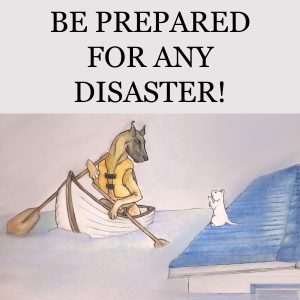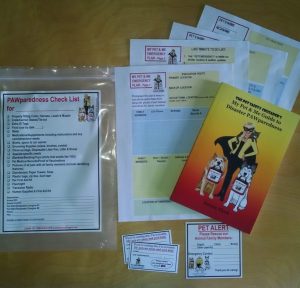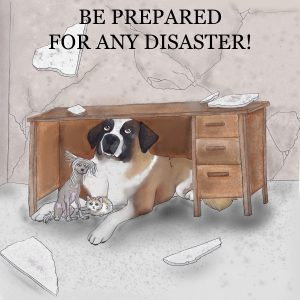 Hopefully you will never experience a fire destroying your home, yet you plan ahead — install fire alarms, smoke detectors and purchase insurance. You certainly hope never to be involved in a car accident, but you have airbags and wear a seat belt (and should safely restrain your pets as well). Being prepared makes sense as we can minimize potential injury to those we love. However, most people are not prepared for a major disaster, and you only have to talk to friends or turn on the news to know that the planet is churning somewhere almost every day…Irma, Harvey, Katrina & Sandy are names best heard on a playground but these powerful wind and rainstorms have wreaked great havoc and cost many lives! La Tuna & Sand are good names for canyons but along with Corona, they are fires that have recently decimated Southern California. Mexico City, our neighbor to the south, has experienced many a heartbreaking earthquake while the Southeast has been pounded by hurricanes and tornadoes, the Northeast suffered through 5 Nor’Easters in early 2018, and the Island of Hawaii…volcanic explosions! Whether the ground shakes, the flames rise or snow and rain fall from the sky, planning ahead is the best way to keep yourself and your animal family safe. As cliché as it sounds…if you fail to plan, you plan to fail!
Hopefully you will never experience a fire destroying your home, yet you plan ahead — install fire alarms, smoke detectors and purchase insurance. You certainly hope never to be involved in a car accident, but you have airbags and wear a seat belt (and should safely restrain your pets as well). Being prepared makes sense as we can minimize potential injury to those we love. However, most people are not prepared for a major disaster, and you only have to talk to friends or turn on the news to know that the planet is churning somewhere almost every day…Irma, Harvey, Katrina & Sandy are names best heard on a playground but these powerful wind and rainstorms have wreaked great havoc and cost many lives! La Tuna & Sand are good names for canyons but along with Corona, they are fires that have recently decimated Southern California. Mexico City, our neighbor to the south, has experienced many a heartbreaking earthquake while the Southeast has been pounded by hurricanes and tornadoes, the Northeast suffered through 5 Nor’Easters in early 2018, and the Island of Hawaii…volcanic explosions! Whether the ground shakes, the flames rise or snow and rain fall from the sky, planning ahead is the best way to keep yourself and your animal family safe. As cliché as it sounds…if you fail to plan, you plan to fail!

At The Very Least
- Place a Pet Alert Sticker near you front door recording how many and what type of animals live there. If you aren‘t home when tragedy strikes, trained professionals (Animal Control Officers and Response Teams) will seek out and help your pets once the humans are accounted for.
- Designate a Pre-Arranged Meeting Place for your family and identify several Places That Can Take Your Pets. Red Cross Shelters do not permit pets, but other organizations are working hard to train communities to set-up temporary animal shelters, yet it could still be days before these facilities are in place. Making arrangements ahead of time with out-of-town friends and relatives is your best bet, but have a Plan B. Susan Keyes, President of the Southern California Animal Response Team says, “Long-term housing and care for pets is the area we have found people to be least prepared.” Check with pet day care and boarding facilities, professional pet sitter as well as your Veterinarian to see if they will accommodate during a disaster. Compile a list of hotels where pets are welcome and set aside one credit card just for emergency use. It’s also a good idea to have cash (in bills smaller than 20s) easily accessible as ATM Machines may not be working. All of this should be included in your written Emergency Plan.
- Stash the following for each pet in an easy-to-carry backpack or crate (that way you’ll have the carrier to evacuate in):
- A three-day to two-week supply of food stored in an airtight container and a manual can opener if needed; water (for medium to large dogs, one gallon per day); medication. Remember to exchange these items regularly so they are fresh when needed.
- A water-proof container with vaccination & micro-chipping records and photos of your pet with your family as proof of ownership.
- Treats, toys, bedding, food & water dishes; Collars/harnesses and leashes; Litter, scoop & boxes for kitties; specialty items for pocket pets, birds, reptiles and amphibians; Disinfectant for cleaning crates, paper towels, flashlight with batteries, zip ties, garbage bags and a well-stocked up-to-date Pet First-Aid Kit, and don’t wait until you need it. Dig through and make sure you know how to use all the contents on your pets.
- Don’t forget human supplies, cause you can’t help your pets unless you are okay too!
Where to Put it All
Even with the best laid plans, life happens, so consider storing your goods in several locations in the event they are un-retrievable when the ground shakes, the flames rise or the mud slides. Positioning items close to an outside wall in your home will allow easier access should buildings collapse and you need to rummage through rubble to get to your supplies. Also, stowing duplicate items in your car is a good idea.

Don’t Forget the Two-Legged Family Members
Also remember to keep a stash of food and other items for the humans including a battery or solar-powered radio, rubber-soled shoes and a flashlight near your bed so that you can help your pets and stay safe!
A GRReat way to get a move on this and benefit from my READY REACT RECOVER system is to take my Pet Disaster Preparedness Certificate Course! Sign up here and get my book or pack, “The Pet Safety Crusader’s My Pet & Me Guide to Disaster PAWparedness” BEFORE you wish you had!
Please also watch my VLOG on this topic at https://youtu.be/Wn0KR52-BtI
Denise Fleck is an award winning author and freelance writer. After extensive training, practice, more training and more practice, she developed her own Pet First-Aid & CPR curriculum and has been teaching animal life-saving skills for close to 20 years with many success stories to share. Additionally she developed a 5 month long Animal Care course for high school students in conjunction with the Burbank Unified School District and Animal Shelter. She has demonstrated animal life-saving skills on CBS –TV’s “The Doctors,” Animal Planet’s “Pit Boss,” “Kirstie Alley’s Big Life” and countless other shows. To complement her teachings, Denise created a line of Pet First-Aid Kits, posters and books for children teaching animal respect and care! Visit www.PetSafetyCrusader.com or call (818) 951-7962.
Note: The articles on this page are copyrighted. Please do not reprint or use portions for any purpose without written permission from the author. Request permission for usage by sending an email explaining how you’d like to use the materials and what parts specifically. Thank you in advance!








